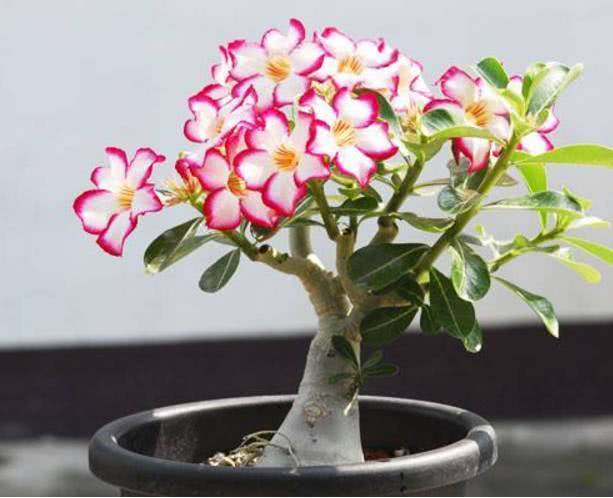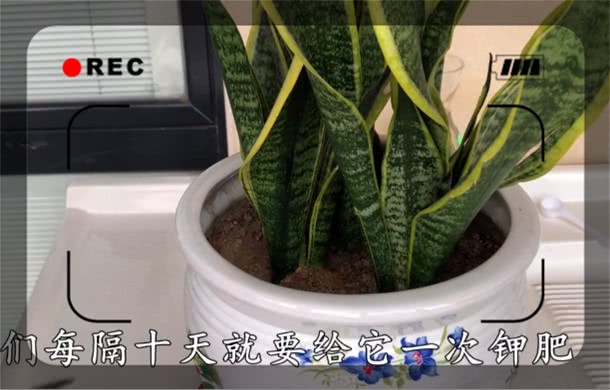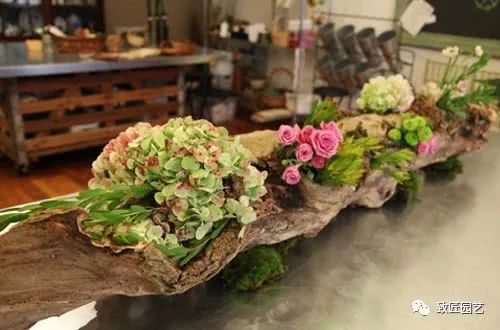Your desert rose habits and maintenance manual has been put online.

We almost passed each other!
Fun, useful, attitude, flowers make life more exciting!
---------------------------
Introduction to Desert Rose
Desert rose (scientific name: Adenium obesum) is also called Tianbao flower, rich flower, sand red flower, Adam flower, dwarf egg flower, etc., belongs to Tianbao flower genus of Apocynaceae, and is often called "desert rose" or "desert rhododendron" in Europe and America. Desert rose belongs to perennial succulent plants, native to Africa Kenya, Senegal to the Middle East Arab desert area. Many friends hear the name of desert rose think it is a kind of rose growing in the desert, in fact, it is not so yo ~ called desert rose because its origin is close to the desert and red as rose.
Desert roses are small trees that can grow up to 2 meters tall in their native habitat. Desert rose base fat, fleshy stem short and thick, needle-shaped leaves alternate on top of stem branches, leaf blade adaxially dark green, abaxially light green and rough. Flowers bloom in late spring to autumn, pink to red, into umbels, 2 to 10 were five-star funnel-shaped set in the branches.
Desert roses are native to dry desert areas and can withstand hot weather. When the temperature is too low or there is a lack of water, desert roses will fall asleep. Proper pruning can promote branching and flowering. Desert roses can be pruned when their branches are more than 30 cm long, usually once every two years. Desert roses need plenty of sunshine, and lack of sunshine can make plants grow too long, thin and prone to disease, and difficult to bloom. However, seedlings or newly potted plants should not be exposed to the sun, and a little shade (25-30% shade) is required at noon in dry and hot summer.
Desert roses bloom at temperatures of 20-35 ° C and can bloom year-round in tropical regions. The optimum temperature for growth is 22℃-30℃, flowering stops above 38℃, and high temperature of 40℃ can be tolerated. It will enter dormancy below 12℃ and overwinter at 10℃.
Desert roses are poisonous. When desert roses are injured, toxic juice flows from the wound, and livestock or children eat stems or milk by mistake, which can cause heart diseases such as accelerated heartbeat and arrhythmia. Plant to avoid touching the outflow of juice, if hands touch immediately with soap and water, such as contact with eyes and mouth, immediately rinse with water and seek medical advice.
About Desert Rose
Temperature: Desert rose optimal growth temperature of 20℃~30℃, is a hot but not cold-resistant plants, so desert rose culture in tropical and subtropical areas.
Illumination: Desert rose nature good high temperature, drought, sunny climate environment. In the growing season of desert roses, receiving more light can help it bloom, and receiving sufficient light in winter can help it survive.
Watering: Desert roses are drought-tolerant, so the amount of watering they should not be too much. Too much watering will easily cause root rot. In spring and autumn need to be fully watered, but each time the pot soil dry again. Summer heat can be watered according to the degree of soil dryness and humidity, gently pinch the belly of desert roses (close to the thick stem of the pot soil) if it is hard, it can not be watered first, if soft, you can water. When winter temperatures drop, water needs to be watered less often.
Fertilization: desert rose preference phosphorus potassium fertilizer, usually a month or so to supplement once. Desert roses grow vigorously in summer, and fertilizers can be combined with slow-acting fertilizers, such as phosphorus and potassium fertilizers. Fertilization can generally be stopped in autumn and winter.
Soil: Desert roses grow close to the desert, so they like sandy soil with good drainage. When the plants grow luxuriantly, they can add some river sand or small gravel to their matrix, which is conducive to drainage. Among them, fertile, loose sand and decaying soil mixed soil is the best.
Types of Desert Roses
Desert Rose
Desert rose is the most cultivated species, it has a strange hammer-shaped fleshy stem and beautiful colored flowers, the plant can be up to 2 meters high, naturally distributed in the stony desert areas of East Africa, flowering in the wild in summer, cultivated varieties almost all year round.
Desert rose
Desert rose flowers are similar to desert rose in appearance, but more flowers, petals edge was corrugated, originally distributed in Namibia desert zone, flowering summer, flowering period without leaves.
Desert rose
A narrow-leaved desert rose native to the deserts of southern Africa, having narrower leaves and narrower petals and purple-red flowers with white stripes at the center, flowering in summer.
Somali Desert Rose
This desert rose is native to the Somali desert region. It is characterized by broad leaves, hairy flowers, purple petals, broad petals, deep purple in the center, and flowering from summer to autumn.
South African Desert Rose
As its name suggests, South African Desert Rose is native to the desert region of South Africa. It has many branched stems, narrow lanceolate leaves, usually clustered at the end of the stem, flowers clustered, pink purple, deep purple in the center, undulate petals, summer flowering.
Arabian Desert Rose
Arabian desert rose native to western asia. It is a dwarf plant with ovate leaves and orange-red solitary flowers on top of stems. The petals have a dark margin. It blooms in summer.
About watering and fertilizing
In terms of watering, when desert roses are in the growing season, watering should be sufficient to keep the pot soil moist, but not too much, because desert roses are drought-resistant and do not like moisture. When watering, pay attention to see dry see wet, dry and thoroughly watered. In summer, when the temperature is high, water needs to be poured once a day, and water can be poured once every two to three days. In winter, when the weather is cold, we should reduce watering and keep the soil dry. We need watering only when the soil is too dry.
In terms of fertilization, in fact, desert roses do not have very high requirements for fertilizer and water. In the summer growing season, we can add more fertilizer to ensure that the plants are luxuriant and the flowers are bright and full. We can stop fertilizing them in winter and let them go into winter dormancy. Desert roses like phosphate and potash, and can be replenished every month or two during the growing season.
In addition, when changing pots for desert roses every spring, we can also apply some long-term base fertilizers in the pots, such as decomposed bean cakes, bone meal, etc.
What if desert roses don't bloom?
In adjusting the existing conditions, we should first consider whether the desert rose is not old enough to bloom, that is, it is very normal not to have a meeting until your desert rose is fully grown. In this case, we can only wait for it to grow and see if it can bloom.
If the desert rose still did not bloom despite the fact that it was not old enough, we could consider other reasons. If desert roses have buds but do not bloom, it may be due to insufficient fertilization, lack of nutrients, or the environment in which they grow is too low in temperature or insufficient in light. If this is the case, we need to actively do a good job of daily maintenance. During the daily maintenance period, we should pay attention to water and fertilizer. You can use thin fertilizer instead of clean water, but it should be noted that when the plant has buds, you need to stop fertilizing, so as to ensure that the flowers do not fall buds. The light and temperature must meet the needs of desert roses to make them grow well.
The best growth temperature of desert roses is between 15 degrees Celsius and 25 degrees Celsius. If our cultivation temperature is not in this range, it may also cause desert roses not to bloom. Desert roses are not cold-resistant, and it is best to keep the indoor temperature above 10 degrees Celsius in winter, which is conducive to the flowering of desert roses.
In addition to the daily maintenance problems, we also need to pay attention to when buying desert roses, do not buy fakes. Some unscrupulous vendors will pass off other similar plants as desert roses, but once they buy them home and care for them, they will find that the plants do not bloom or bloom at all. Xiaobian suggested that we do enough research before buying, so as not to be cheated.
About Yehuang
Yellowing of leaves due to unadaptation to new environment
Desert rose just bought home or brought to a new environment after the need for an adaptation period, in this case a small number of yellow leaves is a very normal phenomenon, we just need to wait for the desert rose to adapt to the new environment.
Yellowing leaves caused by excessive watering
Desert rose is a relatively drought-resistant plants, if watered too much, it will easily cause water in the roots, resulting in root rot, leaf yellow is also an inevitable result. The yellowing of leaves caused by this situation can be solved by cutting off rotten roots and then controlling watering.
Yellowing leaves caused by low temperatures
When the winter temperature is too low, desert roses will enter the dormant period, leaves turn yellow, dry, and even lose leaves, all in order to reduce water evaporation and nutrient consumption, is a self-protection mechanism, so we do not have to worry too much. If you have friends who want desert roses to be evergreen and alive in winter, you can move them indoors and keep them warmer.
Yellow leaves from insufficient light
Desert roses are light-loving plants and need plenty of light to help them grow no matter what season they are in. If the light received is insufficient, it will cause the yellow leaf problem of desert roses. At this time, we can remove the desert rose from the shade and place it in a place with light, and make sure that it can get enough sunlight every day.
... the yellowing of leaves caused by excessive fertilization.
If too much fertilizer is applied to desert roses, it will make the soil impermeable, and the extracellular solution concentration is too high, and the root cells are easy to lose water and die. The result of both is root rot until death. The way to solve this problem is to apply fertilizer appropriately and avoid excessive fertilization.
About rotten roots
First of all, when we find that desert roses have rotten roots, we should carefully pull them out of the soil in time. We can loosen the soil first to help us extract the plants more easily. After pulling it out, shake off the remaining soil.
Then, with a pair of sterile sharp scissors, quickly cut off the rotting roots, along with the old roots and excess roots.
Then we use the potassium permanganate solution diluted with water prepared in advance to disinfect the cut surface of the root to prevent the growth of bacteria. The concentration of potassium permanganate solution should be controlled at about 0.1% for the best. Then apply clean plant ash to the cut surface.
After these steps, load the plants into new pots. When putting on the pot, the wound and the severely damaged part of the root system should be filled with clean wet sand, and then covered with clean cultivation soil to promote the germination of new roots at the wound.
As we change pots, we also prune a lot of branches and leaves, sometimes cutting 80 to 90 percent of the branches and leaves to ensure survival. In the process of plant recovery and growth, try to keep the pot soil moist, spray water on dry branches frequently, put an end to fertilization, and do not let the pot soil rain to prevent root rot again.
==========
The gardener says-decorate life with flowers
Share the dry goods of flower cultivation and flower protection, let the gardener accompany you to decorate the colorful home world!
- Prev

Tiger orchid watering point, this no longer rotten roots, rotten leaves continue to sprout crazy growth easy to burst pots
Hello, everyone, I am the editor of this issue, I am very happy to meet you again. Recently, many people have complained to Xiaobian that tiger skin orchid is always dead and spoiled. In fact, we all know that tiger skin orchid is particularly easy to raise and is very suitable for novice breeding...
- Next

Dead wood turns into a flowerpot in spring?
A mottled dead wood, the trunk has been eroded by the years is no longer complete, but it can become a good natural flowerpot, put bright flowers inside, provide them with a warm and comfortable place to live, once again have the new meaning of spring. ...
Related
- Wuhan Hospital Iron Tree Blooming Result Was Instantly Frightened by the Gardener Master
- Which variety of camellia is the most fragrant and best? Which one do you like best?
- What is the small blue coat, the breeding methods and matters needing attention of the succulent plant
- Dormancy time and maintenance management of succulent plants during dormancy
- Minas succulent how to raise, Minas succulent plant pictures
- What are the varieties of winter succulent plants
- How to raise succulent plants in twelve rolls? let's take a look at some experience of breeding twelve rolls.
- Attention should be paid to water control for succulent plants during dormant period (winter and summer)
- Watering experience of twelve rolls of succulent plants
- Techniques for fertilizing succulent plants. An article will let you know how to fertilize succulent plants.

